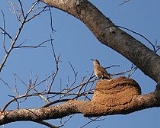
Hornero
Encyclopedia
The horneros are members of the genus Furnarius in the family Furnariidae
, native to South America
.
Horneros are brown birds with rather short tails and fairly long bills. They are known for building mud nests that resemble old wood-fired oven
s (the Spanish
word "hornero" comes from horno, meaning "oven"). While many Furnariids have different nests, the hornero nest is the reason for the common name
applied to the entire family
; Ovenbirds (though unrelated to the Ovenbird
, which is a parulid warbler). The size and exact shape of the hornero nest varies depending on the species. They generally lay 2–4 eggs, although the breeding behavior of the Bay Hornero is virtually unknown.
Adult horneros can frequently be seen sitting on top of their nest. Disregarding the uncommon and relatively shy Bay Hornero, horneros are typically fairly common and highly conspicuous birds. They are generally noisy. All horneros are partially terrestrial
, and commonly seen walking on the ground with a relatively up-right posture.
The Rufous Hornero is a national emblem
of Argentina
, one of the several countries it inhabits.
Ovenbird (family)
Ovenbirds or furnariids are a large family of small suboscine passerine birds found in Mexico, and Central and South America. They form the family Furnariidae...
, native to South America
South America
South America is a continent situated in the Western Hemisphere, mostly in the Southern Hemisphere, with a relatively small portion in the Northern Hemisphere. The continent is also considered a subcontinent of the Americas. It is bordered on the west by the Pacific Ocean and on the north and east...
.
Horneros are brown birds with rather short tails and fairly long bills. They are known for building mud nests that resemble old wood-fired oven
Wood-fired oven
Wood-fired ovens, also known as wood ovens , are ovens that use wood fuel for cooking. There are two types of wood-fired ovens: "black ovens" and "white ovens"...
s (the Spanish
Spanish language
Spanish , also known as Castilian , is a Romance language in the Ibero-Romance group that evolved from several languages and dialects in central-northern Iberia around the 9th century and gradually spread with the expansion of the Kingdom of Castile into central and southern Iberia during the...
word "hornero" comes from horno, meaning "oven"). While many Furnariids have different nests, the hornero nest is the reason for the common name
Common name
A common name of a taxon or organism is a name in general use within a community; it is often contrasted with the scientific name for the same organism...
applied to the entire family
Family (biology)
In biological classification, family is* a taxonomic rank. Other well-known ranks are life, domain, kingdom, phylum, class, order, genus, and species, with family fitting between order and genus. As for the other well-known ranks, there is the option of an immediately lower rank, indicated by the...
; Ovenbirds (though unrelated to the Ovenbird
Ovenbird
The Ovenbird is a small songbird of the New World warbler family . This migratory bird breeds in eastern North America and moves south in winter.-Taxonomy:...
, which is a parulid warbler). The size and exact shape of the hornero nest varies depending on the species. They generally lay 2–4 eggs, although the breeding behavior of the Bay Hornero is virtually unknown.
Adult horneros can frequently be seen sitting on top of their nest. Disregarding the uncommon and relatively shy Bay Hornero, horneros are typically fairly common and highly conspicuous birds. They are generally noisy. All horneros are partially terrestrial
Terrestrial animal
Terrestrial animals are animals that live predominantly or entirely on land , as compared with aquatic animals, which live predominantly or entirely in the water , or amphibians, which rely on a combination of aquatic and terrestrial habitats...
, and commonly seen walking on the ground with a relatively up-right posture.
The Rufous Hornero is a national emblem
National emblem
A national emblem symbolically represents a nation. Most national emblems originate in the natural world, such as animals or birds, but another object may serve. National emblems may appear on many things such as the national flag, coat of arms, or other patriotic materials...
of Argentina
Argentina
Argentina , officially the Argentine Republic , is the second largest country in South America by land area, after Brazil. It is constituted as a federation of 23 provinces and an autonomous city, Buenos Aires...
, one of the several countries it inhabits.
Species
- Pale-legged HorneroPale-legged HorneroThe Pale-legged Hornero is a species of bird in the Furnariidae family. It includes the Pacific Hornero and the Caribbean Hornero , which often are considered separate species.It is found in Bolivia, Brazil, Colombia, Ecuador, Guyana, Peru, and Venezuela...
(Furnarius leucopus).- Pacific Hornero (Furnarius (leucopus) cinnamomeus).
- Caribbean Hornero (Furnarius (leucopus) longirostris).
- Bay (or Pale-billed) Hornero (Furnarius torridus).
- Tail-banded (or Wing-banded) Hornero (Furnarius figulus).
- Lesser HorneroLesser HorneroThe Lesser Hornero is a species of bird in the Furnariidae family.It is found in Brazil, Colombia, Ecuador, and Peru.Its natural habitat is subtropical or tropical moist shrubland.-References:...
(Furnarius minor). - Rufous HorneroRufous HorneroThe Rufous Hornero, Furnarius rufus, is a large ovenbird from eastern South America. Also known as the Red Ovenbird, it is a common species of second-growth scrub, pastures and agricultural land, and the species is often seen near areas of human inhabitation...
(Furnarius rufus). - Crested HorneroCrested HorneroThe Crested Hornero is a species of bird in the Furnariidae family.It is found in Argentina, Bolivia, and Paraguay.Its natural habitat is subtropical or tropical dry shrubland.-References:...
(Furnarius cristatus).
External links
- Hornero videos on the Internet Bird Collection

